|
 Mixed Plate
Mixed Plate
Me and My Cameras
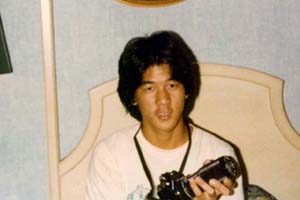
Goofy Neal and his Nikon EM, circa 1982
My Introduction Into Surf Photography
Way back when I was in the eighth grade (around 1978), I was foraging
through some cabinets to check out some of my family's photo albums.
It was then that I came across my dad's old SLR camera--very old (at
least 20 years old) but still in decent working condition. My dad
let me use camera, thinking that I might get interested in photography.
Little did he know that this would spark in me a huge interest and
love for the art of photography.
I was just starting to gain interest in bodyboarding, so it was a
logical progression for me to start shooting surf.
I don't remember the model number, but I do remember that it was
a simple, manual camera with built-in light meter to set exposure.
My dad suggested that I first start shooting in black and white, so
that's what I did.
In hindsight, it was good that the camera was manual. It gave me
a good understanding about how to work exposure settings. It also
really established mechanical skills on how to focus and zoom.
Surf photography was especially challenging to me because focusing
on a moving target was so hard initially--seemingly a hit-or-miss
effort. The first rolls of film had less than half the images in fair
focus. Eventually, with a lot of practice, I slowly improved.
Also, I learned the subtle nuances of surf photography-when to shoot,
what angles worked, exposure, etc. This is still a work in progress,
continually trying to refine my timing and accuracy.
Although I'm mostly self-taught, gotta acknowledge Bernie Baker.
His comments about my work along with some small suggestions and a
better understanding of the publishing process has challenged me to
improve.
Cameras That I've Loved
Here's a listing of cameras and gear that I've used. Each had its
virtues. Click on the image to see a sample photograph.
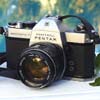 Pentax SLR w/50 and 200 mm lens. (1978-1982) First SLR camera
used, mostly manual, very sturdy. I really wanted a Canon AE-1, but
in retrospect, it was a good way for me to learn the basics. Gave
back to my dad in the end.
Pentax SLR w/50 and 200 mm lens. (1978-1982) First SLR camera
used, mostly manual, very sturdy. I really wanted a Canon AE-1, but
in retrospect, it was a good way for me to learn the basics. Gave
back to my dad in the end.
 Ewa Marine bag. (1980-1982) Borrowed the bag from a friend
and tried it out with the Pentax. Very very cumbersome to use and
got spotty results. Still, this was my first attempt at water photography,
and it fueled my desire to shoot from the water.
Ewa Marine bag. (1980-1982) Borrowed the bag from a friend
and tried it out with the Pentax. Very very cumbersome to use and
got spotty results. Still, this was my first attempt at water photography,
and it fueled my desire to shoot from the water.
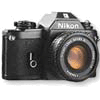 Nikon EM. (1982-1986) Built like a tank, the EM was a very
compact and light SLR. After I bought it I found out that Nikon wanted
to build a small camera for a women (if I knew that, I wouldn't have
bought it). I actually dropped it in saltwater twice and it still
ran. Film advance crank broke off, but the camera still was operational.
Eventually got stolen.
Nikon EM. (1982-1986) Built like a tank, the EM was a very
compact and light SLR. After I bought it I found out that Nikon wanted
to build a small camera for a women (if I knew that, I wouldn't have
bought it). I actually dropped it in saltwater twice and it still
ran. Film advance crank broke off, but the camera still was operational.
Eventually got stolen.
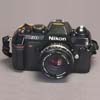 Nikon N2000. (1986-present) Nikon's last new model that did
not have autofocus capability (if you don't count the FM2), it was
a replacement for the EM. Another solid camera. No DX film exposure
sensing, and has a shutter speed up to only 1/1000th second. Still
going strong. I don't think I ever changed the camera battery.
Nikon N2000. (1986-present) Nikon's last new model that did
not have autofocus capability (if you don't count the FM2), it was
a replacement for the EM. Another solid camera. No DX film exposure
sensing, and has a shutter speed up to only 1/1000th second. Still
going strong. I don't think I ever changed the camera battery.
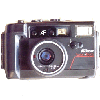 Nikon Action Touch. (1988-1990) A neat point-and-shoot camera
that was waterproof. Had a flash, so could do some cool effects in
the water. Worked well in snowy conditions too. Eventually deep-sixed
it--I think I didn't close the camera well.
Nikon Action Touch. (1988-1990) A neat point-and-shoot camera
that was waterproof. Had a flash, so could do some cool effects in
the water. Worked well in snowy conditions too. Eventually deep-sixed
it--I think I didn't close the camera well.
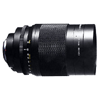 DNikon 500 mm mirror reflex lens. (1989-present) Obviously
this is not a camera, but it did change my surf photography dramatically.
I have had this lens for over 12 years now, on "permanent loan" from
my friend. It's a manual focus lens that is short and stubby. Being
out of focus brought out these "donuts" of light on the edges (from
the mirrored optics). Aperture is set at F8.
DNikon 500 mm mirror reflex lens. (1989-present) Obviously
this is not a camera, but it did change my surf photography dramatically.
I have had this lens for over 12 years now, on "permanent loan" from
my friend. It's a manual focus lens that is short and stubby. Being
out of focus brought out these "donuts" of light on the edges (from
the mirrored optics). Aperture is set at F8.
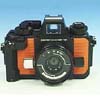 Nikonos V. (1991-present) This is an absolute tank of a camera.
Nice, big 35 mm lens. Fully manual with an LED readout for exposure.
The mirror on my camera got jarred out of place, so I can't use the
readout, but it doesn't matter--having film exposure calculations
in my head makes it easy. (ASA 100, Bright sunlight, F8, 1/500--changing
f-stop up one, will require changing shutter speed down one). I spit
on my lens and rub it around to help sheet water droplets.
Nikonos V. (1991-present) This is an absolute tank of a camera.
Nice, big 35 mm lens. Fully manual with an LED readout for exposure.
The mirror on my camera got jarred out of place, so I can't use the
readout, but it doesn't matter--having film exposure calculations
in my head makes it easy. (ASA 100, Bright sunlight, F8, 1/500--changing
f-stop up one, will require changing shutter speed down one). I spit
on my lens and rub it around to help sheet water droplets.
 Minolta GX-4. (1997-1998) Used APS film, which has lousy film
quality (small negative size) and a 7:4 aspect ratio. The actual camera
lens was located on the bottom of the plastic clear lens, bad for
water photography since the water dripped down right over the aperture.
Plastic lens eventually hazed over, rendering the camera useless.
Minolta GX-4. (1997-1998) Used APS film, which has lousy film
quality (small negative size) and a 7:4 aspect ratio. The actual camera
lens was located on the bottom of the plastic clear lens, bad for
water photography since the water dripped down right over the aperture.
Plastic lens eventually hazed over, rendering the camera useless.
 FujiColor QuickSnap Waterproof 800. (1998-present) Since the
price has gone down (on sale for $7.49 for 27 exposures), this camera
is a viable option for beginning water photography. I almost always
surf with one. With good lighting and a steady hand, can provide surprisingly
good results. Kodak has one too, but I prefer the Fuji.
FujiColor QuickSnap Waterproof 800. (1998-present) Since the
price has gone down (on sale for $7.49 for 27 exposures), this camera
is a viable option for beginning water photography. I almost always
surf with one. With good lighting and a steady hand, can provide surprisingly
good results. Kodak has one too, but I prefer the Fuji.
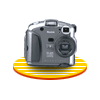 Kodak DC-260 digital. (1998-2001) This was my first foray into
digital camera technology. Really changed the way I took pictures.
Bootup and trigger response was painfully slow. I loved having the
ability to shoot and reshoot until satisfied. Photo quality was marginal
(1.5 megapixels) and shooting action was difficult (slow lens and
slow shutter response). It was recently stolen, just in time for a
new technology refresh. Rechargeable batteries are essential.
Kodak DC-260 digital. (1998-2001) This was my first foray into
digital camera technology. Really changed the way I took pictures.
Bootup and trigger response was painfully slow. I loved having the
ability to shoot and reshoot until satisfied. Photo quality was marginal
(1.5 megapixels) and shooting action was difficult (slow lens and
slow shutter response). It was recently stolen, just in time for a
new technology refresh. Rechargeable batteries are essential.
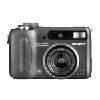 Sony Cybershot DSC-S85. (2001-present) Our new 4.1 megapixel
digital camera is good and bad. Have not played with it enough to
provide a qualified review. Optical zoom is only 3x (not adequate
for tight surf photography).
Sony Cybershot DSC-S85. (2001-present) Our new 4.1 megapixel
digital camera is good and bad. Have not played with it enough to
provide a qualified review. Optical zoom is only 3x (not adequate
for tight surf photography).

|